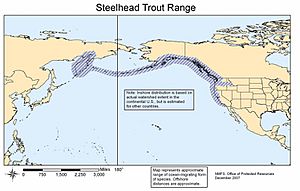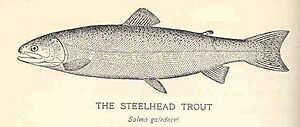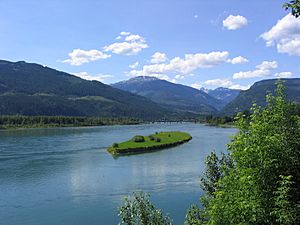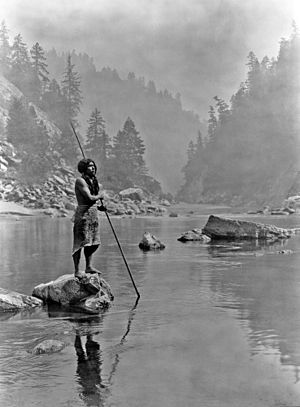Steelhead trout facts for kids
The Steelhead Trout is a special kind of rainbow trout that lives in both fresh water and the ocean. It's known as an "anadromous" fish, meaning it starts in fresh water, moves to the ocean to grow, and then returns to fresh water to lay its eggs. Steelhead are naturally found in rivers and oceans across North America. They have also been introduced to many other parts of the world. These fish often hide behind plants, rocks, and fallen trees for safety. They travel to their spawning grounds in both summer and winter.
Contents
What is a Steelhead Trout?
The Steelhead Trout is actually the same species as the rainbow trout. The main difference is that steelhead travel to the ocean and come back to rivers to lay eggs, while rainbow trout stay in fresh water their whole lives. Steelhead are usually bigger and less colorful than rainbow trout. They can grow up to 55 pounds (26 kg) and be 45 inches (114 cm) long. They can live for up to 11 years and can lay eggs multiple times in their lives.
Steelhead trout have a shiny, silver body and a rounded head. They have black spots and a red or pink stripe along their sides. Their silvery color and strong build remind people of steel, which is how they got their name.
Sadly, many groups of steelhead trout in the United States are now endangered or threatened. This is mostly because dams block their paths in rivers. Human activities have greatly reduced the number of steelhead trout.
Amazing Features of Steelhead Trout
Steelhead Trout are very important to the economy and culture in places like Northern California. They are a coastal type of the same fish as the rainbow trout. Rainbow trout stay in fresh water, but steelhead travel to the ocean. This ocean-going lifestyle has given steelhead unique features that help them live in many places along the Pacific Northwest coast, including California.
Steelhead trout are also good indicators of how healthy California's streams are. If there are many healthy steelhead, it usually means the streams are in good condition. Their shiny, silver underside and olive-gray back, which looks like steel, are their most famous features. Other physical traits include:
- A blunt head and short jaw that does not go past the eye.
- Clear dark spots on their top fin.
- A square-shaped tail fin with spots that spread out.
- Often a reddish stripe along their sides and a reddish gill cover.
- They can grow up to 45 inches long.
Steelhead Trout are predators that live in the ocean and usually live for 4 to 6 years. When they are young, they eat tiny water creatures called zooplankton. As they get older, they eat fish eggs, small fish, crabs, snails, insects, and even mice in fresh water. In the ocean, they eat squid, crustaceans, and small fish like anchovies and sardines.
Unlike salmon, which usually die after laying their eggs, steelhead trout can go back to the ocean and return to the rivers to lay eggs several times. This ability to travel between fresh and salt water is called being anadromous.
How Steelhead Find Their Way Home
One of the most amazing things about steelhead trout is their ability to find their way back to the exact stream where they were born, even after spending years in the vast ocean. This is called "homing behavior."
Steelhead remember the unique chemical smell of their home stream. After feeding in the ocean for 1 to 4 years, they use the sun's position and the Earth's magnetic field to navigate. Then, they use their incredible sense of smell to find their way back to their exact hatching grounds. This chemical memory helps create different groups of steelhead that are unique to each river basin, stream, and even specific spots within a stream. This means that steelhead populations in different areas can have different timing for their migrations, different sizes, and even different behaviors.
Reproduction and Life Cycle
During spawning, female steelhead trout lay their eggs on gravel bottoms in fresh water rivers. The female digs a nest called a "redd." She prefers to dig in water that is about 6 to 14 inches deep. After she lays her eggs, a male fish fertilizes them. The female then covers the eggs with gravel. Depending on her size, a female can lay up to 9,000 eggs. The eggs stay buried in the gravel until they hatch.
As mentioned before, unlike salmon, which usually die after spawning, steelhead can return to the ocean and come back to the same streams to lay eggs several times.
Where Steelhead Live and Why They Matter
Steelhead Trout are naturally found in North America, west of the Rocky Mountains, along the coast. To help their populations and for sport fishing, many hatcheries (places where fish are raised) have been built across the United States, including in Idaho, Pennsylvania, and New York. The most famous and historic steelhead fishing areas are in Alaska, Washington, and Oregon, which are known as "The Pacific Northwest." Idaho also has many steelhead, with over 20 hatcheries helping to stock fish in its cold rivers and streams.
In Northern California, the number of steelhead has gone down over the past few decades due to too much fishing and pollution in rivers like the Russian River. However, thanks to new efforts to protect and rebuild native fish populations in Washington and Oregon, fishermen are seeing more steelhead in the Northwest.
The National Oceanic and Atmospheric Administration (NOAA) has identified 12 important population groups of steelhead trout across the Pacific Northwest. Many of these groups are threatened, and some are even endangered, mainly because of city growth and past conservation efforts that didn't quite hit the mark. But there is hope for their recovery.
Steelhead trout need good habitats, clear paths to their spawning grounds, and to survive well in both the ocean and fresh water. They play a very important role in their environment because their health shows how good the water quality is. They are also a key food source for many animals, including bears, eagles, and humans.
Because steelhead need clean water and healthy environments, their populations have struggled in areas with a lot of human activity and pollution. When steelhead numbers go down, it often means the habitat quality in those urban areas is also getting worse. The story of steelhead is closely tied to humans because these special fish have great cultural meaning in American history. Their future survival depends a lot on our efforts to protect them.
History and How People Used Them
For a long time, trout have been an important food source for people living in the Pacific Northwest of the United States and British Columbia. Many Indigenous groups, like the Salish, Okanagan, and Tahltan, traditionally relied on trout as a major part of their diet.
Steelhead were especially valued. Not only did they provide nutritious meat, but they also showed how healthy the rivers, streams, and oceans were. They were seen as a sign of good water quality and a thriving ecosystem. Many tribes, like the Gitksan, even considered steelhead their most important food source. Different tribes caught steelhead at different times of the year, depending on when the fish were most available.
Traditional Fishing Methods
Indigenous tribes used many clever ways to catch steelhead trout. These included:
- Weirs: These were fences or dams built in rivers to guide or trap fish.
- Gaffs and Poles: Long poles with hooks used to pull fish out of the water.
- Nets and Spears: Used to catch fish directly.
- Fish Wheels: Large wheels that scooped fish out of the water.
- Harpoons and Leisters: Three-pronged spears.
- Traps and Hooks: Various types of traps and hooks for fishing.
- Early Trolling: Dragging a baited line behind a boat.
The Tahltan Tribe
The Tahltan tribe used spears and weirs. When weirs were banned in the early 1900s, they started using gill nets more. They also used cylindrical trap baskets, hand nets, and gaffs with hooks in shallow waters.
The Nootka (Nuu-chah-nulth) Tribe
On Vancouver Island, Nootka men used weirs, traps, leisters, and harpoons to catch steelhead.
The Salish Tribes
The Coast Salish tribes were very inventive. They made fishing lines from stinging nettle and U-shaped hooks from bone. They also used "tidal weirs" that used the ocean's tides to push fish into small bays. Then, they would use "river weir-traps" to catch the fish, which they would then harpoon or spear in shallow water.
The Bella Coola Tribe
The Bella Coola tribes had unique trapping methods. They would corner steelhead using two different traps, forcing the fish to jump into waiting baskets. Each village of the Bella Coola tribe had its own special right to trap and catch steelhead on the Bella Coola River.
The Thompson Tribe
Along the Thompson River, this tribe used a clever trick: they would use pitch-lamps (lamps made with tar) to attract steelhead trout to the surface. Once the fish were at the surface, they would be speared, harpooned, or caught with hooks.
Dangers and Threats
Steelhead Trout are an important food source for many animals, depending on where they live. They are "tertiary consumers," meaning they eat other predatory animals like smaller fish. Animals that eat steelhead trout include:
- In fresh water: Lampreys, birds like ospreys and eagles, bears, raccoons, river otters, and humans.
- In the ocean: Various types of sharks, seals, sea lions, and even orcas.
However, the biggest danger to steelhead trout is human activity. People building cities and polluting the environment have destroyed the natural places where steelhead used to thrive. Rivers and ocean areas in places like Northern California, where steelhead are usually found, have seen fewer fish over time.
In Southern California, the future of steelhead trout is even more uncertain. Old reports and photos from the early 1900s show that steelhead were once common in places like Orange County and the Los Angeles River. They were found in areas like Steelhead Creek near Dodger Stadium, the Ventura River, and the San Juan Creek. Their populations even extended south to San Diego County.
NOAA says that habitat damage is the main threat to Northern California steelhead. This damage comes from removing plants along riverbanks, too much dirt in the water, changes in water flow, poor water quality, and problems in river mouths where fresh and salt water mix. Human activities like logging, ranching, mining, building dams, diverting water, and pollution have all contributed to the decline of steelhead populations.
Protecting Steelhead Trout
Since the 1940s, when steelhead numbers dropped dramatically, many conservation programs have been started. The main reason for their population decline is human-made obstacles in rivers, like dams that block their migration paths, or changes to rivers for recreation and water access. In Southern California, it's estimated that only about 500 steelhead trout return to their home rivers. However, in some other parts of the United States, steelhead are actually seen as a problem because they are an invasive species (a species that is not native and harms the environment).
Southern California Steelhead
While steelhead numbers are getting better in parts of the Pacific Northwest, the California Steelhead Trout is considered a threatened species. The Southern California steelhead are the most endangered of all. Their populations started to decline in the late 1940s because of changes humans made to the landscape. Dams built for flood control increasingly blocked steelhead from migrating from the coast to their spawning grounds upstream. Also, as cities grew, river flows were changed for recreation, and a lot of water was taken out of rivers. Because of this widespread habitat loss, Southern California Steelhead were officially listed as an endangered species in 1997. In some areas, steelhead haven't been seen in years, and biologists are very worried.
Northern California Steelhead
Northern California steelhead have been a threatened species since 2000, but they offer hope for recovery. In 2016, nearly 49,000 steelhead trout were reported caught, showing that these amazing fish are still surviving in Northern California waters. To keep helping them recover, a strong plan for steelhead conservation is needed.
The State of California Fisheries Restoration Grant Program (FRGP) has invested over $250 million and supported about 3,500 projects to restore salmon and steelhead. These projects focus on improving fish passage (making it easier for fish to move), water quality, restoring river habitats, monitoring watersheds, and educating people. These efforts are helping to improve Northern California steelhead populations. More than 20% of the floodplains and river habitats have been restored thanks to FRGP. Even with these efforts, habitat damage continues to happen at an alarming rate, so ongoing conservation is very important.
Images for kids







